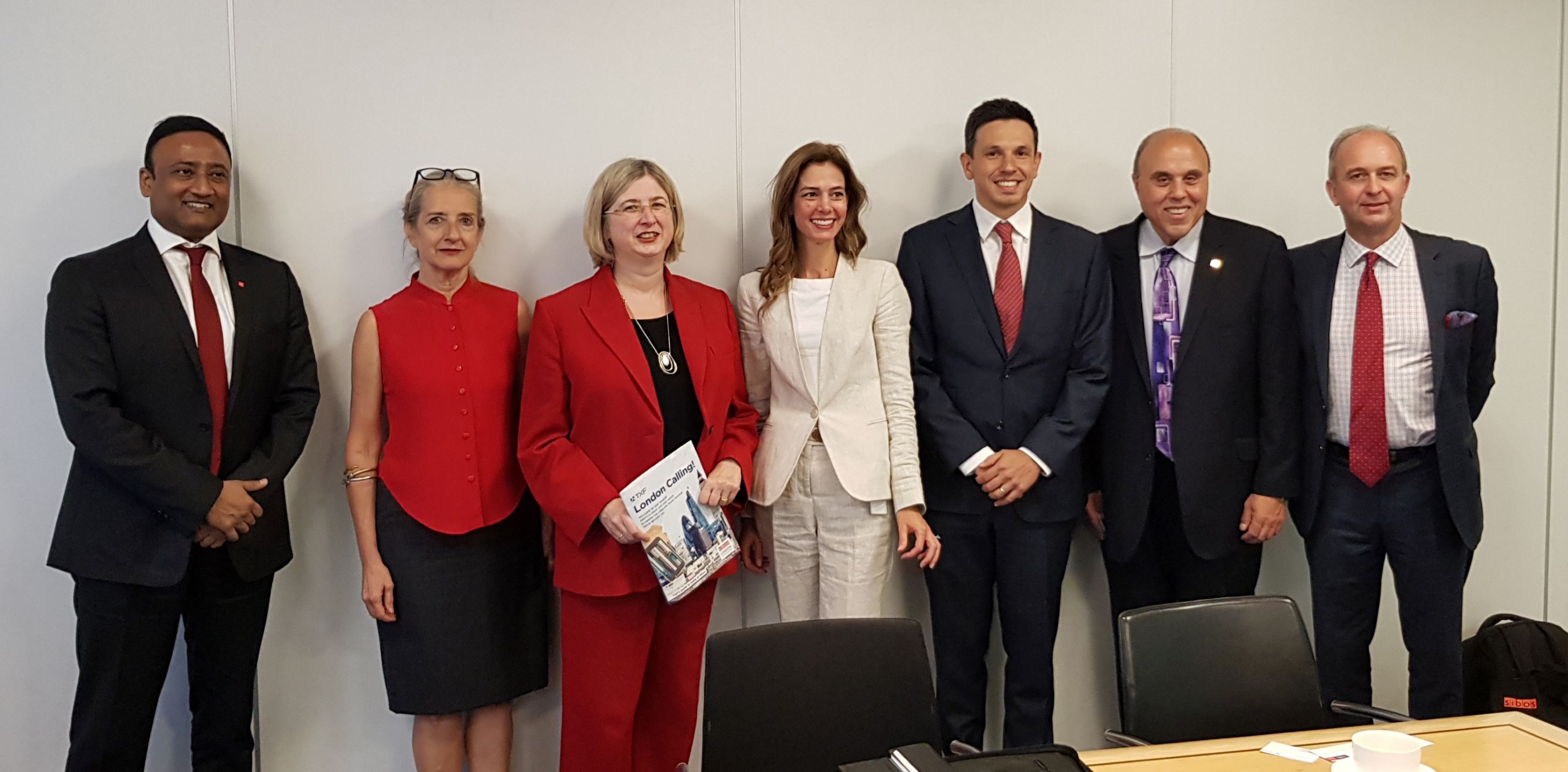Finding the sweet spot on trade digitisation and working capital management
Are corporate treasuries, fintechs and banks missing a trick on cross border working capital optimisation and what will the next five years hold? TXF's roundtable discussion of digitisation and international trade hosted in London by DBS highlights where the sweet spots will lie.

 Participants
Participants
Rodrigo Martins, Trade Finance Manager, Czarnikow
Rory Kaplan, Director, Senior Offering Manager, CGI
Cindy van Niekerk, Blockchain Implementation, TradeIX
Sriram Muthukrishnan, Group Head of Trade Product Management, DBS
Ann Rutledge, Founding Principal and CEO, CreditSpectrum Corp
Sean Edwards, Chair, International Trade and Forfaiting Association (ITFA)
Katharine Morton, Head of Trade, Treasury and Risk, TXF [moderator].
TXF: What is it corporates and banks actually want and need from trade digitisation?
Sriram Muthukrishnan: DBS is a very digitally focused bank. We do have a traditional suite of trade solutions, such as letters of credit, supply chain finance (SCF) and factoring and forfaiting. But we are keen to go beyond – to offer higher value to our clients. First is to engage customers differently and digitally, for example, using Application Programming Interfaces [APIs]. We feel it is the easiest way for multiple customers to engage with us without having to really go through cumbersome implementation processes. We've had great customer take up on that and the feedback has been very positive. The second thing we are trying to do is to get better at harnessing the power of data. Whether it is through our own systems and processes or tying up with the regulators and other partners to access data.
An example would be the launch of Digibank by DBS in India, which is a ground breaking mobile-only offering in India. Within two years, we onboarded over 2.5 million Digibank customers in India. We're continuing to make progress on the wholesale banking side as well. For example, on SCF in China, we offer customers the ability to provide leads on their suppliers, where these suppliers can be completely onboarded digitally to their anchor’s SCF programme, without the need to open an account with us. So we don't need suppliers to come in face-to-face or ask for oodles of paper. We verify their company credentials online and we are able to onboard them within a day or two, which is not the usual experience for SCF programmes.
The third thing we've done, again in China, is tied up around blockchain. It's an interesting technology for us. We're not part of any large consortia at this point of time, but we are increasingly exploring blockchain. We were happy at one point of time not to be part of any consortia [at Proof of Concept (PoC) stages]. But having seen some of it take off, I think it's a good time for us to start wetting our feet. What we have therefore been doing is taking a co-creation approach with our clients to focus on developing specific solutions aimed at solving real business pain points, over creating PoCs in isolation with fintechs.
TXF: How is that working?
Sriram Muthukrishnan: In China, for example, we worked with Wanxiang blockchain in which we co-created a solution for the automotive industry where you can track the movement of, say, the shipment of 10 cars across China from hauler to hauler into the hands of a distributor. This can now happen instantaneously rather than over, say, 45 days. These SMEs were almost going out of business, but we were actually able to give them money on day one, rather than day 45. They may still be struggling, but this helps.
We love to be part of co-creation projects which add value. We’re not big fans of PoCs but we want to be able to sit down as part of a 4-D customer journey process – with customers and partners like fintechs , where we go through the discovery process to gather insights about their pain points, define the problems to solve and the opportunities, develop the solution by experimenting and refining, and then delivering and implementing it.
TXF: So yours is a ground-up process?
Sriram Muthukrishnan: Yes. We now have a large repository of successful digital use cases which can be replicated, say, for other automotive companies in China and India. Once you’ve proved the concept, not as a PoC but as a real use case, you can easily say, “yes, this works”.
Rory Kaplan: What if you go down that road and the customers don’t like it?
Sriram Muthukrishnan: Typically we co-create and develop the solution together with the customer. So let's say that you have an automotive supply chain issue that you want to address, we will have some of our experts in both technology and product, as well as anyone else we need getting into a room together – we then spend a lot of time brainstorming and whiteboarding. It's a joint solution. It may not work at first go, but then we can refine it, and we can go to the suppliers and get a real pulse check of whether it actually works for the various parties. At the very least you've done so much discovery that what we find is a solution that's almost there, and you can continue to tweak and improve on it.
The whole process was excellent in the example I gave for supplier digital onboarding. Before that, the onboarding had been a bit slow. Part of the supply chain build-out was actually to develop this portal where we could do a seamless, fully electronic onboarding, such that the suppliers didn't have to come queue at a branch.
The regulations in China on how many cars can be on the same cargo from a safety perspective has changed, which is a problem for profitability. That's difficult, and we can only solve for so much. But at least we are honest about it and the way we went about it, the anchor company is so bought into the solution that they are also trying to find ways to make it successful – changing the numbers or haulers or the kinds of orders given – it becomes a business decision that is done together. It's really exciting because you're actually in the business, you're actually understanding real problems.
TXF: Rodrigo can you give a corporate’s eye view of what you want and need from banks and fintechs on trade?
Rodrigo Martins: Czarnikow is a global supply chain service business with over 150 years of experience. To put it simply, having a common ‘aggregator’ would help. We come across different solutions, and everyone is exploring new ways of doing things which is great, but we haven’t found anything that brings everything together. We are managing diverse and complex supply chain flows with multiple buyers, suppliers, logistics providers, financiers and credit insurers – all with different levels of technology adoption. So it’s challenging at the moment to find the right technology solutions that we should be onboarding to effectively save us time and money.
Digitisation may save you time in one particular process of a trade flow, but then there are many other trading, documentary and financial aspects that have not been digitised yet, so all the effort you make to onboard on one solution is not worth it. Perhaps corporates could work on parallel project pilots that might bear fruit later, but they are not going to be changing their entire business on that basis.
Sean Edwards: That’s very consistent with the Boston Consulting Group/ICC survey that came out at Sibos, one element of which was what do banks and corporates want. The biggest disconnect, which you’ve just confirmed, is that a lot of banks want to come up with clever products and tweak things like reverse factoring and payables financing, but what the corporates want above anything else is simple, operational, or as you call it aggregators, common denominator solutions for all of this, and are happy to receive, for example, traditional documentary credits like LCs, if they can be delivered in an operationally efficient way.
Rory Kaplan: Isn’t it interesting. We get the same feedback from corporates through the banks that millennials, especially who have grown up in a digital world, are growing into higher positions. You come to trade and you get paper and these antiquated processes, they want a digital experience for trade and they are not getting it so far. We're moving bits and pieces, but not really completely.
Rodrigo Martins: And government entities too, if you are talking about Customs, and other aspects involving logistics – there are no common denominators in different countries. There are cases where some large buyers are saying to their suppliers that they need to use a particular fintech or technology platform. But in our market, we cannot deal with customers in that way.
Cindy van Niekerk: There’s a ripple effect. We hear that banks are saying they want to listen to their customers, their corporates. So Marco Polo is facilitating this through the inclusion of corporates in piloting, and we’ve had and have, many successful pilots going on. But at the end of the day, that’s not where the buck stops. You’re saying the reach needs to be longer. Once you’ve onboarded, say, Marco Polo, you then struggle with the follow through, the ripple effect. It feels like we’re not digging deep enough yet to hear where that problem originates.
Sriram Muthukrishnan: Sometimes it feels as if we’re trying to couch the problem in very broad terms. And that’s why I find if you say, ‘I’m trying to digitise the whole of trade,’ that’s a very bold statement. You’ve got to go silo by silo and defragment. If you have a commodities trade, you have to figure out what happens. For example, how do you deal with your freight forwarder, how do you deal with your customs agency, etc.
It’s easier for me to talk about these things because the Singapore government has set out the Networked Trade Platform (NTP) which is becoming a reality. We’ve had a few, admittedly smaller, corporates signing up for it and it’s easier for them to get customs declarations digitally and to pass them to their bank digitally. So you can start passing more data to your chosen bank in a digital format rather than accumulating it all and presenting it.
Cindy van Niekerk: But the digital chain is not long enough yet.
Sriram Muthukrishnan: It’s not long enough, and it’s broken.
Sean Edwards: Everyone wants uniformity and standards. You’ve spoken about a couple of them, but there’s three. One way is what’s happening in Singapore – the pioneering way where the government has a single window and quite a prescriptive/directive way of doing things. The other one is chaotic, but out of chaos comes a form, the way millennials look at things and end up with a simple denominator. So if I look at SCF, one of the things that we're talking about in Marco Polo is actually what is a payment obligation? What does it look like? Where does it exist? How many tentacles does it have as it have, does it have two heads, 10 legs? We don't know the shape of it yet. We know it's got to be something that calls itself a payment obligation.
Is it, as we’re looking at it in ITFA, and BAFT has done work on, a digitised promissory note? Or is it something brand new and how does that exist in the digital space? The other solution, which is probably undesirable, is that everyone uses the same platform.
Sriram Muthukrishnan: I wouldn’t say the NTP is prescriptive. They say they are making it easier to access government services through a single window. There’s an onboarding process where there are incentives given to SMEs and MSMEs such as getting value added services at a subsidy [for example, subsidised ERP systems which can be used to create invoicing, standardised documentation, etc, to help exporters]. It’s fantastic that the regulator is getting behind it.
In Asia, we're also seeing Hong Kong setting up eTradeConnect and Shenzhen coming up with its own blockchain-based network. The best thing for me is we talked about this interoperability, which is where these three regulators are talking to each other and asking, ‘can we have an umbrella where we can have a network of networks?’
TXF: It’s interesting what the regulators are doing, particularly the NTP in Asia. Their focus has been on SMEs and MSMEs. Does it solve for multinationals and should, say, the big ERP providers such as SAP be doing things that have ‘trade’ stamped on them?
Sriram Muthukrishnan: I think the processes the regulators are trying to support, particularly in customs and the digitisation of bills of lading, are core capabilities available for everyone. Really large corporates don’t need to subsidise their ERP systems, but could benefit from the other processes and it’s an important step in the right direction. It doesn’t mean you don’t need the likes of Marco Polo, for example, because that’s where you generate [business] but you need to be interoperable with what NTP is trying to do. It’s not in silos any more.
Cindy van Niekerk: Exactly. Interoperability is being a little bit more forgiving.
Rory Kaplan: Also to your point, there are certain targeted solutions where this fits in. For example, I asked one bank which had just created a blockchain for guarantees on the retail side about standards. They answered, ‘we just determined that these are the standards for this solution…there’s one form, this is your guarantee’. We are going to see these targeted solutions continuing and change is going to be incremental and will take time.
What’s discouraging is that a year ago we were talking about a lack of standards and that ICC and BAFT were working on developing them. A year on, there’s been some progress, and with the recent takeover of the Universal Trade Network (UTN) by the ICC to help develop standards there is hope this will continue in the right direction. However, there is still much work to do.
Cindy van Niekerk: I think there’s been a lot of progress. That’s where the UTN, now the Digital Standards Initiative (DSI), came from, which originated out of the Marco Polo consortium because we realised there’s been a lack of standards. If I say ‘it's black’ and you say ‘it’s black’, are they actually both black? The standards are definitely driving a lot of this. You look at, say MIFID [and MIFID II, the EU’s markets in financial instruments directive], which has imposed a massive amount of standards on the finance industry. Standards will grow and if you’ve got standards, that drives transparency and data flow.
Rory Kaplan: It’s absolutely necessary for blockchain, and interoperation between platforms will totally be dependent on standards, but it’s a tough road. You talk about ERP systems: you can have a wide variety of different EDI [Electronic Data Interchange] purchase order messages, and that’s been a challenge for years. That made each implementation of an ERP, uploading purchase orders and invoices, expensive for the bank and risky because that customer could leave after the bank has built the interface, which is a problem. You’re right that maybe targeted solutions and some of these other efforts will push it together, but it will take time.
TXF: From a corporate perspective for trade how much of this are you actually seeing or does this all seem to corporates as just ‘noise’ between banks and fintechs at the moment?
Rodrigo Martins: Fintechs are growing so fast, and there are some that have come to us with interesting propositions to streamline our processes. Banks have also come to us, but the banks themselves don’t have a uniform approach, and most of them are still investing in different platforms or collaborating with other banks to find that common denominator. For example, on our roadmap for trade finance digitisation we had bank integrations as one of the milestones we wanted to achieve this year, but this is proving to be more difficult than we envisaged due to the various approaches different banks have to authenticate trade finance instructions.
Also, we have global trade finance lines and each country has different compliance regulations which is adding complexity to this integration exercise, so we moved that integration target from this year to 2020. Although fintechs are approaching us, and they have proved their own solutions, we can’t put all of our eggs in one basket. Financial regulations are still trying to catch up with recent technologies but at a slower pace, and we don’t feel confident enough as an FCA-regulated company that necessary regulatory requirements have all been met.
Sean Edwards: One solution may be to look at the corporate consortia, like Komgo and Vakt, which are creating the platforms and defining the standards. As a bank [SMBC] that does a lot of commodity finance, we are immediately attracted to that approach. There’s always a chicken and egg with fintech of who will create it and what it’s going to be, but there’s always a commercial perspective. We invest in consortia such as Marco Polo because with 30-plus banks it’s the biggest consortia. But then, in a way, I thought [the DBS] approach is interesting and I understand why you don’t get involved in the PoC stage. PoC is looking for a problem then finding the solution, but I think now this has moved on and corporates see that they actually need to do something. They have this issue around different standards, different commercial propositions and they’re getting together on things like Komgo.
Rodrigo Martins: I agree, and when you look at other commodity traders they are getting together and collaborating on their own initiatives. So yes, you need to join an initiative as such. But sometimes these initiatives aren’t very open and you’re not always part of those ecosystems. On that note, we have instead decided to focus on being blockchain and technology ready. We have many things that we still want to develop internally and digitise to be innovative where necessary, and we said let’s be ready internally so when it’s possible to connect, we can.
TXF: What is the sweet spot between trade digitisation and cross-border working capital optimisation?
Cindy van Niekerk: The sweet spot is where you look at a Venn diagram of a bank with the clients and the regulators coming together in that space in the middle. That's the sweet spot, because a) you've listened to the clients, b) you've ticked the regulatory box, but also you can, as a bank and an institution, still do the business that you need to do at the end of the day.
Sriram Muthukrishnan: Are we leaving too much on the table? That is the question. Because if you’ve narrowed down the sweet spot too much…
Cindy van Niekerk: The sweet spot is dynamic and it’s going to grow. If you look at the regulators, they aren’t digitally ready yet and they’re sitting on the bench seeing how all this is going to play out and trying to understand what the industry wants and what they need to do from a regulatory perspective to accommodate some of the changes.
Sean Edwards: The Bank of England is very accommodating, building sandboxes and bringing people together but it’s not coming down on one side or another or choosing one commercial solution. It’s a very dynamic space. The Singaporean government has taken a different approach…
Sriram Muthukrishnan: India is also a good example. For their GST network, with information that will soon be available for validating trades domestically, you will be able to avoid duplicate financing. There is also something called TReDS [Trade Receivable e-Discounting System] where companies can put up accepted invoices and get financing. There’s a lot of activity in China too, which is solving real problems.
In Singapore you may have seen what we’ve co-created with Halcyon [HeveaConnect] for the rubber industry, solving real problems of proving provenance of the rubber traded on the platform. But it will have to progress incrementally as what works for rubber will have to be customised to work for other commodities like sugar, etc.
Rodrigo Martins: Actually one of our main drivers to track and trace sugar movement is our sustainability programme, VIVE. When you see bulk cargos and how much sugar is comingled it’s not an easy task, but we have already achieved important milestones and partnerships that are taking us to the place we want to be.
Sean Edwards: That’s why an industry/ecosystem approach is important and data is key, we’re just starting to get to grip with what’s inside a single supply chain.
Ann Rutledge: Not to jump too far away from the subject but from the standpoint of using data to validate a credit and find a price that's appropriate for the risk, it's not really a question of sweet spot so much as blind spot.
The big blind spot in that process is the calibration step. You've got the data, you've got the models, and how do you map them, and to what? A unitary system of measurement standards? Again, that's what's missing. Because the rating agencies historically have filled the role of credit analysis.
If you studied finance theory, they don't talk about credit. It's not part of the academic finance canon, you just learn it. But each rating agency has its own scale. It has its own units of measure for calibrating and they're all different. And so it becomes very similar to landing in an airport and you've got five different foreign exchange counters. Which one you choose? The cheapest one. But that's not necessarily correct. And it might only work for sugar, or for this asset type or another asset type. It's like you've got, say, 236 different types of models at Moody's, just like cheeses in France. And that's the problem that we're trying to solve.
Rory Kaplan: It's really interesting because we're looking at analytics to provide help in these credit decisions that you're talking about. What's the supplier performance, what's the buyer performance? A couple of years ago, we were talking to people that were saying performance is really becoming the criteria more than other factors that were used in the past. So we presented these solutions to our banks, but there hasn’t been a lot of interest.
TXF: Hasn’t been? Why?
Rory Kaplan: Some are doing this on their own enterprise systems. But what we are seeing there are companies out there that are really advancing with machine learning and analytics. Because the volume of data has increased significantly, the questions are now becoming more significant. It’s progressing in the direction of using natural language processing and the analytics to provide answers to clients. It’s not there yet, but it’s going in that direction.
TXF: Where do you see the digitisation journey in five years' time? Is it all locked up with the future of SCF? Will digitised trade be part of working capital management?
Rory Kaplan: In two to three years it is going to be very different. I think a lot of the things we're talking about here are going to progress. There's going to be progress on data. I think analytics is going to progress with utilising these other technologies such as machine learning which will help with making recommendations on things like credit. The core customer experience is going to improve. So whether it's fintechs working in collaboration with the banks or maybe inspiring the banks through innovation, it's going to provide a better customer experience. It has to be that way. I’m positive and I think we’re on the verge of this transformation taking place.
TXF: Given we’re discussing this in the shadow of Sibos, do you think SWIFT will be part of this with gpi, the KYC Register, etc, will that evolve into trade?
Sriram Muthukrishnan: SWIFT has woken up, from being quite sleepy. I see this with gpi, etc, and equally with trade, they want to follow and understand how blockchain fits, particularly with last mile delivery and fulfilment. As the largest consortium of banks in the world they have a lot of value, and I’m in favour of using what we have created together over many decades.
Cindy van Niekerk: Their KYC solution is something the industry has been crying out for – some statistics say that for every corporate onboarding by a bank you need at least 100 documents. Multiply that by every bank, it’s an operational nightmare. If SWIFT can combine new technology like AI and natural language recognition it would make the overall process so much easier, as it would eliminate the human factor out of the filtering process. The wheels of change in this space needs to spin a bit faster.
Sean Edwards: And with the minimum thresholds it doesn’t address the SMEs and the big opportunity in trade we’re not banking, which in part is because of KYC regulations. So will regulators allow you to do KYC based on publicly available sources powered by robots, which currently is unacceptable?
Cindy van Niekerk: It is doable if you can get a regulator convinced that the information that, say, the HMRC provides, the information that the utility company provides, the information that some of the other credible validators can validate a person. The validators validate the information and provide that information back out to the financial institutions. That's a very simple solution, but it's blockchain based.
Sriram Muthukrishnan: Why do you say ‘but’? It doesn’t matter but blockchain may offer the solution we need.
Cindy van Niekerk: It’s a massive database that’s needed. And you’ll have to jump across the hurdles of GDPR along with where the data actually then sits. I agree the regulations may actually need to be relaxed a bit but at the end of the day the validators need to be on that blockchain based business network as it provide the secure transfer on sensitive information. Coming back to your original question, five years from now, Marco Polo will just be one of the network orchestrators. There will be many others, and with interoperability with all, everyone’s lives will be so much easier.
Rodrigo Martins: I believe in blockchain and in five years’ time it is likely we will be already doing something around it. But certain things will still be paper-based and I don’t see everything being electronic in five years’ time. Efforts in terms of promissory notes will mean things are more electronically-enabled and negotiated on an electronic basis. There are movements forward. The tech bit is done and it works, and solutions that are still in progress for legal aspects around title and negotiable instruments should create the foundation for people to be confident that assets are exchanged in a compliant and secured manner. These will start to bear fruit. And banks are realising they need to deploy solutions that are more client focused and accessible, in order to achieve the adoption they need for their new platforms.
Sean Edwards: A good example of negotiable instruments are bills of lading. We know what essDocs and Bolero are trying to do on that, but they always come against a legal brick wall. It still hasn’t been solved. There are some great model laws around. One of the reasons digital promissory notes haven’t taken off is because banks can’t get happy that they can take security over [the underlying] but if they can, there’s a whole financing stream of digital negotiable instruments available there which could revolutionise [trade finance]. It’s frustrating that we haven’t got further with that after years of talking about it.
Rory Kaplan: We haven’t really talked about what happens to a lot of the banks out there that are not really doing anything in this space, and there are a lot of them out there. They will likely fall off, or be left behind.
Sriram Muthukrishnan: In five years’ time we would have solved the bills of lading problem for sure. With the pace at which everyone is focusing on it, there has to be a solution. In five years, banks will win business based on customers’ experience. It won’t be about balance sheet, or about bills of lading or paper, it will be customer experience that decides with whom you will bank.
And lastly, consortia that are being formed will have to open up. Yes, some banks have invested time and effort getting them to a certain stage, for which many thanks. But if they now decide to create barriers to entry, the whole principle is dead in the water. Yes, thanks for the investment and trouble, but unless you open up and democratise it, it will never take off.





